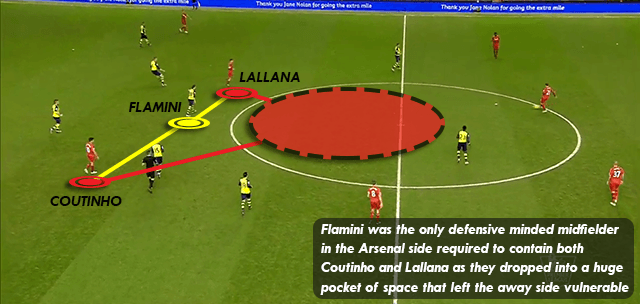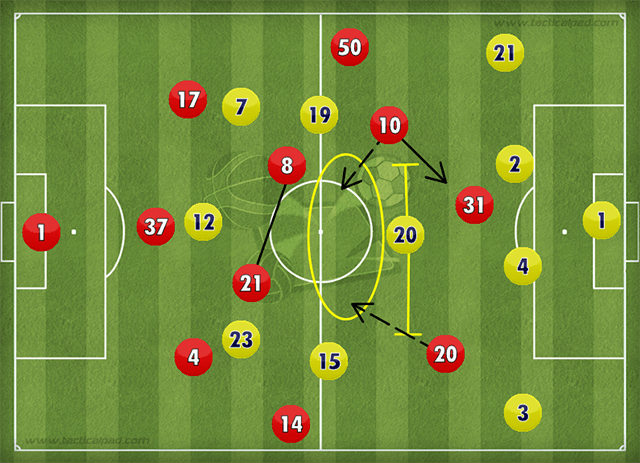It was a reverse of narratives as two struggling sides went head-to-head. Liverpool, for the first time this season, impressed with their performances, displayed fluidity in attack and composure in possession while Arsenal were dominated, pegged back, but showed a rare occurrence of efficiency, coming away with a point.
LIVERPOOL 2-2 ARSENAL

Liverpool (3-4-3): 1. Jones // 4. Toure, 37. Skrtel, 17. Sakho // 14. Henderson, 21. Lucas, 8. Gerrard, 50. Markovic // 10. Coutinho, 20. Lallana, 31. Sterling
Arsenal (4-3-3): 1. Szczesny // 21. Chambers, 2. Debuchy, 4. Mertesacker, 3. Gibbs // 20. Flamini, 19. Cazorla, 15. Oxlade-Chamberlain // 7. Sanchez, 23. Welbeck, 12. Giroud
Substitutions: 74′ Borini (Markovic), 81′ Lambert (Toure) // 82′ Coquelin (Giroud), 90′ Campbell (Chamberlain), 90+3′ Monreal (Sanchez)
Flamini left under-pressure as Liverpool exploit the midfield
“Make-shift” would be the best way to describe Arsenal’s line-up at Anfield as they were left to deal with a barrage of injuries and an added lack of personnel in the squad. Mathieu Debuchy took up a rare spot in central defence, Alex Oxlade-Chamberlain played an unfamiliar role in midfield, Santi Cazorla who would much prefer to be higher up was left to play in a deeper role. While it did seem like a frightening attack on paper, the vulnerability in defence was clear even before a ball was kicked.
With Liverpool opting for their new 3-4-3 formation in recent weeks, it allowed them to play with a more fluid front three. Playing wing-backs in the form of Jordan Henderson and Lazar Markovic meant that that fluid three up ahead could be concentrated in central areas with no dependency on them in wide positions.

This was further helped by the fact that Mathieu Flamini was the only defensive minded midfielder in the Arsenal side required to contain both Philippe Coutinho and Adam Lallana as they dropped into a huge pocket of space that left the away side vulnerable. The French midfielder struggled to do the job of containing both the attacking midfielders, providing cover for the back line, assisting in areas out wide when Cazorla and Chamberlain couldn’t and this led to huge amounts of pressure on the 30-year-old.
Steven Gerrard, Lucas Leiva and occasionally Liverpool’s back three were able to play direct balls from deep into that pocket of space, allowing the creativity to flow. As Arsene Wenger did mention post match, his side seemed to be extra cautious as they were reminded of last season’s demolition at the hands of Liverpool; this meant they did have enough men back to prevent too much of space in the attacking third unlike in the middle third. Liverpool had tons of possession in the zone between their own half and the zone occupied by the Arsenal back-line. It still needed some doing to break-through the defensive line as Wenger’s men attempted to make it tight.
But when Arsenal did attack, they went ahead with numbers. A front three of Olivier Giroud, Danny Welbeck and Alexis Sanchez was assisted by the attack minded Chamberlain and Cazorla to make a five man attack against a five man Liverpool defence plus two wing-backs depending on the phase of play. Though with the added cushion of Henderson & Markovic tracking back, retaining possession before Arsenal created too much trouble in the Liverpool half wasn’t as difficult as it should have been for the home side.

And these scenarios again meant that Mathieu Flamini was the sole cover for the defence which was left exposed as Liverpool countered Arsenal’s rare attacks. Both Lallana and Coutinho had their moments in the first half dropping deep to pick up possession and drive at the defence, while front man Raheem Sterling did so too, easing his way in with his pace. When passes weren’t being played in for retreating attackers, there were opportunities for them on the ball to run into similar acres of space.
Liverpool shift to a 3-4-1-2 as Arsenal fail to react
Half-time may have brought contrasting emotions in the dressing room; Liverpool dominated proceedings, Arsenal struggled but both got two late goals which would certainly have effected their second half approaches.
Had Debuchy not scored his stoppage time equalizer, Wenger may well have changed things around in search of an equaliser. But despite Liverpool exposing the midfield, he seemed to realise their lack of clinical touch in the final third and was happy to keep things as they were (Flamini remained exposed). Brendan Rodgers though saw an area to exploit.
Though Liverpool had exposed a central area, they lacked a man who could directly play in that zone as both Coutinho and Lallana were cutting in and dropping deep centrally from rather wide areas. Liverpool shifted into a 3-4-1-2 in the second half as Rodgers realised the opportunities opening up in Arsenal’s vulnerable midfield, settling it up for an attack minded midfielder like Coutinho. Rodgers opted to put the 22-year-old in a completely central position, directly up against Flamini who now apart from the Brazilian had both a retreating Lallana and Sterling to contain. Lazar Markovic’s bursts forward helped this to pan out, while Jordan Henderson’s defensive mentality meant Liverpool had considerable men back besides their three central defenders when the Serb ventured forward (Mamadou Sakho would shift left, replicated by the rest of the defence, allowing Henderson to slot in as a fourth defender occasionally).

Sterling now slowly started playing more in wider areas (until a completely wide role when Fabio Borini was brought on), while Lallana was more central up ahead to allow the 3-4-1-2 to function.
Though neither Arsenal’s exposed midfield in a 3-4-3 or the 3-4-1-2 directly effect the scoreline, it allowed the home side to create chance after chance which on another day or with better finishers would have seen a more devastating scoreline. Coutinho himself had atleast two opportunities which he should have taken, scuffing shots from the edge of the box, while the lack of a natural striker certainly aided Arsenal’s case.
Arsenal’s disappointing front-line
Coming into the game, plenty of talk involved Alexis Sanchez who Brendan Rodgers missed out on in the summer, with the Chilean opting for the Emirates as his preferred destination. The ex-Barca man has been in outstanding form and containing him would have been Rodgers’ primary objective pre-match.
Although it was he who won the free-kick and provided the initial delivery for the all important equaliser that changed the complexion of this fixture, his impact on the game overall was rather disappointing. Easily dispossessed when in possession and generally kept quiet, Wenger was even forced into shifting Sanchez to the other side having started on the right. Liverpool’s wing-backs combined well with the wide central defenders on their flank to contain the 26-year-old while centrally the likes of Lucas were competent at keeping his influence minimal.
But Sanchez wasn’t the only attacking player to disappoint. Danny Welbeck started on the opposite side with Olivier Giroud central as Arsenal looked to be depending on the counter for majority of their attacks. But, as is explained later, things didn’t quite go according to plan meaning that neither of the front-three were able to have a sustained impact on the game. Olivier Giroud did threaten whenever he got the ball in advanced positions, but this in itself was a rarity. Welbeck struggled in his wide role, only really helping with his pressing, but failing to provide much directly in attack.
The red points above are touches from Arsenal’s front three of Giroud, Sanchez & Welbeck while the blue represents Liverpool’s trio of Sterling, Lallana & Coutinho. Besides having lesser touches, the graphic represents how poorly the Arsenal players performed in attacking areas. There was virtually nothing inside the box, negligible around it and no impact from deeper central areas. Liverpool’s three certainly outperformed their counter-parts.
Having said that, efficiency was key for Arsenal. With Cazorla’s forward runs and despite the fact that the away side failed to produce too many opportunities, they still managed to take the rare clear chance created from open play. That second goal allowed them to sit back and be less dependent on the efficient but disappointing front three.
Liverpool for their part may have been encouraged by their ability to create and influence proceedings in advanced areas, but if similar chances presented Arsenal’s three as the ones the home side created, we may have had a far different scoreline given the quality on Wenger’s attackers.
Double pivot
Like Liverpool managers before him, Brendan Rodgers has opted for the use of a double pivot in recent weeks, restraining from dropping defensively awkward Steven Gerrard and instead assisting him by deploying Lucas Leiva in the same zone.

Liverpool’s captain has constantly been poor in his displays, failing to do the simple tasks required of a defensive midfielder. In Lucas the side have a natural player to play the role; Rodgers combined the two and the partnership certainly became effective. The two alternated well in their phases of play – Lucas had moments bursting forward from midfield as Gerrard stayed back to provide cover in case of a counter, but more often it was the former playing his more natural defensive role as Liverpool’s captain throttled forward.
Lucas and Gerrard’s pivot allowed Henderson and Markovic move forward with ease, knowing fully well that men were back to defend against counters (a strategy Arsenal looked to rely on but rarely got an opportunity). With the front-three and wing-backs joining up in attack and the pivot staying back, Liverpool often had 5 men in the opposition half and 5 in their own. Despite dominating possession, rarely did they lack that 4-5 man cover in their own half as Arsenal’s bid to pull Liverpool out and break, never transpired.
Failure to exploit wide areas
While Liverpool’s 3-4-3 is proving to be effective, acting as a solution to their weak attack and finally providing much needed cover from midfield for it’s back line, it still has it’s weakness like any formation. It’s a weakness that Arsenal’s set-up seemed to be looking to take advantage of.
The area vacated by the wing-backs should have been overloaded by the wide men in Welbeck and Sanchez, giving Giroud a clear one-on-one with Martin Skrtel as the other two defenders would have been stretched. This could further have been done by the use of Arsenal’s full-backs. But Kieron Gibbs and Calum Chambers rarely got forward while Sanchez and Welbeck struggled to have an impact out-wide. The more central midfielders in Chamberlain and Cazorla actually did a better job out wide, though this left them exposed in midfield.
Interestingly, the rare moment that Gibbs did get forward and over-loaded Liverpool’s right led to that lead-taking second goal from Giroud, ofcourse created by Arsenal’s best player on the night – Cazorla. It was strange that Arsenal didn’t expose this weakness in Liverpool’s 3-4-3 and it’s variations, as not only was that the obvious thing to do, but the set-up looked to do just that.
Where does this leave them?
12 months back at this stage last season, Liverpool sat pretty on top of the Premier League table, ahead of second placed Arsenal only due to a superior goal-difference. It’s a far different story this time round though. The draw didn’t help either side as despite the 5 point gap, both sets of managers are under-pressure and desperately looking to get back into the top four.
Written by Sami Faizullah




























































